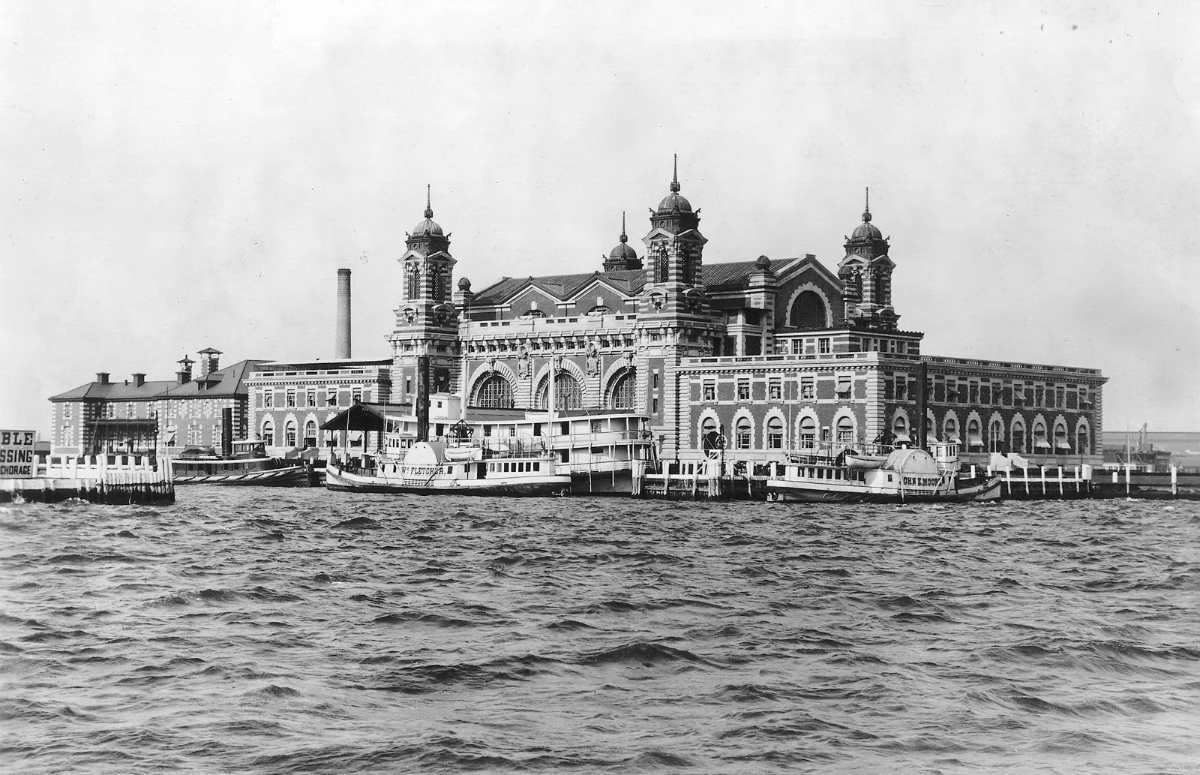What was the primary function of Ellis Island, and how was it built? Why are there so many different cultures in the United States today, and how were Ellis Island immigrants accepted or rejected? Where did Ellis Island immigrants come from, why did they migrate, and, most importantly, why did they aim to immigrate to America?
Today, “Ellis Island” is probably an unknown thing to many people. But tightly connected with the term “American Dream,” Ellis Island is an unparalleled part of United States history. This is the place that gave birth to the “American Dream” slogan, where millions of immigrants were gathered, inspected, and taken into the country.
The largest immigration in world history started in 1820 and took place in 100 years, with 30 million Europeans coming to the United States. From January 1892 on, a large part of this flood of people moved through a “funnel” only 30 meters wide, the Registry Room of Ellis Island, the immigration station of the port of New York.
How Did Ellis Island Open?
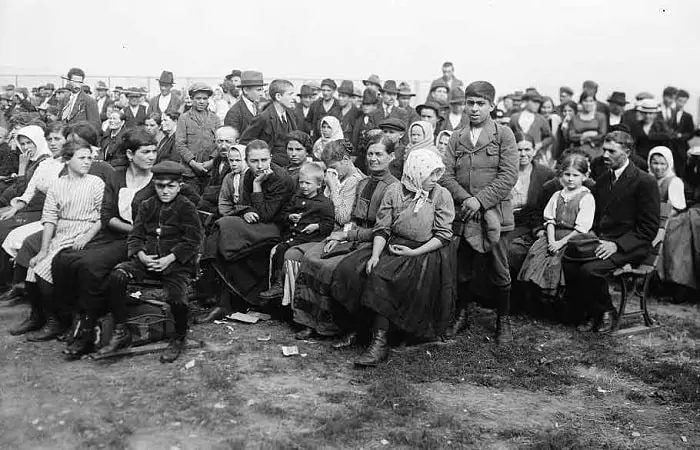
The immigrants who arrived in the US at the turn of the century were motivated by the prospect of freedom, a job, and wealth. They transformed America into a mosaic of cultures and languages unlike any other country in terms of diversity.
For thirty-five years before Ellis Island opened, immigrants, numbering 476,000 in a single year, landed at Castle Garden at the tip of Manhattan. Castle Garden, which could only hold 5,000 people at the time, was run by the state of New York from 1855 to 1890, during which 8 million immigrants were processed. State laws were broken by bullying, fraud, or pressure from the ever-increasing number of immigrants. By the 1880s, Ellis Island had a reputation as a place where new arrivals fell into the clutches of swindlers or were bribed by officials.
In 1891, the federal government created a new Bureau of Immigration and chose the 3.3-acre (1.3-hectare) Ellis Island as the new reception station. Named after its former owner, the island had been fortified and used as an armory during the War of 1812 against Britain. The government opened the new station in several wooden buildings and also reclaimed the water body around the island, which quadrupled the size of the land by 1893.
After 1892, 72% of the immigrants passed through New York Harbor, of which 8 or 10% entered through Ellis Island. In total, roughly 12 million people entered the United States through Ellis Island. 4 out of 10 Americans today can trace their ancestry back to this place. Devastated by a fire in 1897, the center was renovated with a red brick building with four towers. In the center of the building was the large Registry Room, flanked by kitchens, dormitories, and a laundry.
The Undesirables
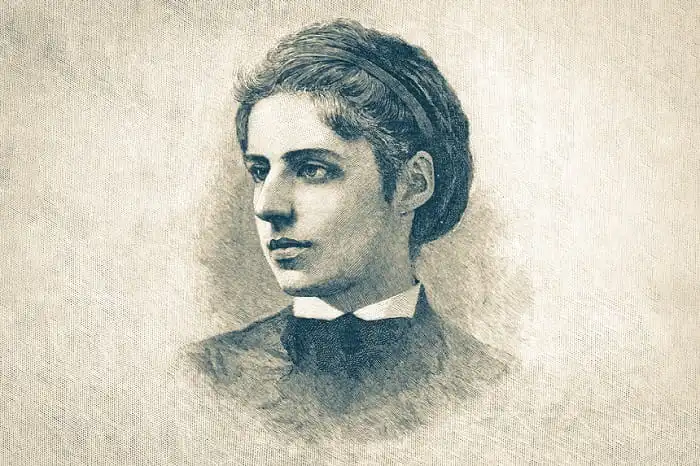
One of the purposes of the Registry was to screen out the “undesirables.” Initially, those screened out were categorized as the mentally ill, criminals, the poor, and those with “disgusting or contagious diseases.” Newcomers were not allowed to have a job waiting for them, lest employers try to underpay them. Gradually, more “undesirable” classes were added to the list: polygamists, prostitutes, and anarchists.
Before the arrivals disembarked, immigration officers boarded the ships for a preliminary inspection. First-class and second-class passengers were allowed to enter immediately and did not have to pass through Ellis Island. In contrast, deck and hold passengers, mostly very poor people, were given identification cards and taken on barges to the reception station. As the boats brought them to Ellis Island, they were greeted by the majestic Statue of Liberty, newly erected in 1886. On it was a poem by the Jewish poet Emma Lazarus, which had been placed on a pedestal with a bronze plaque.
“Give me your tired, your poor,
Poet Emma Lazarus
Your huddled masses yearning to breathe free,
The wretched refuse of your teeming shore.
Send these, the homeless, tempest-tost to me,
I lift my lamp beside the golden door!”
The new immigrants had no way of knowing whether they would be able to “breathe freely.” Newspapers described this experience as the closest analog on earth to the Last Judgment.
Health Examinations
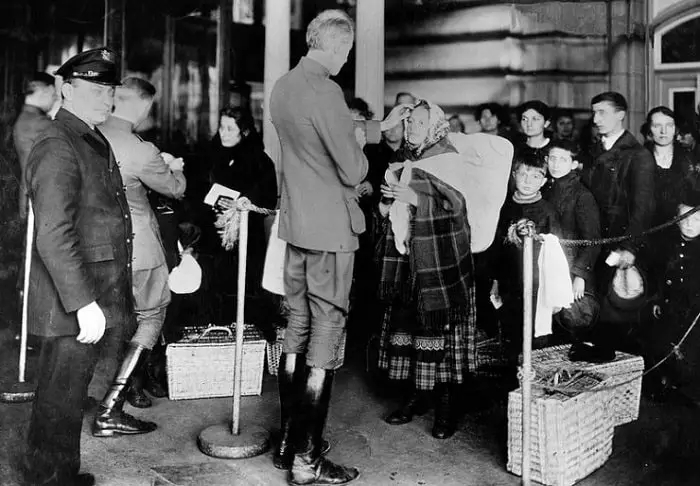
The immigrants brought to Ellis Island entered the Great Hall in single file, walking through iron bars known as “cages.” Their medical examiners looked for health defects and noted their findings in chalk on their shoulders: G for goiter, K for hernia, and X for mental retardation. They were checked separately for infectious diseases. The most common reason for rejection was trachoma, which could lead to blindness. Then came the registration process, where, with the help of an interpreter, the migrants were asked about 30 questions, such as “Do you have money?” “Can you read and write?” “Who paid your fare?”
Officials occasionally scribbled false information in front of these animated villagers. Many immigrants were said to have left Ellis Island under a false name. A “Johannes” could turn out to be Joe Arness; a German was so frightened that he answered “Ich vergessen!” (I forgot), and his name was recorded as “Ferguson.” It was a mind-boggling, brutal process that led to the center being dubbed the “Island of Tears,” but there were relatively few refusals. Only 2 out of 10 would-be migrants were sent back, usually not because they were “undesirable,” but because they might become a burden on the state in the future.
Once out of the hall, the Ellis Island immigrants would retrieve their belongings, join their families, and then board ferries to either New York or New Jersey. Clutching their bundles of clothing and relieved to have saved their lives, it was time to set off to make a new life for themselves in an unknown land.
Where Did the Immigrants Come From?
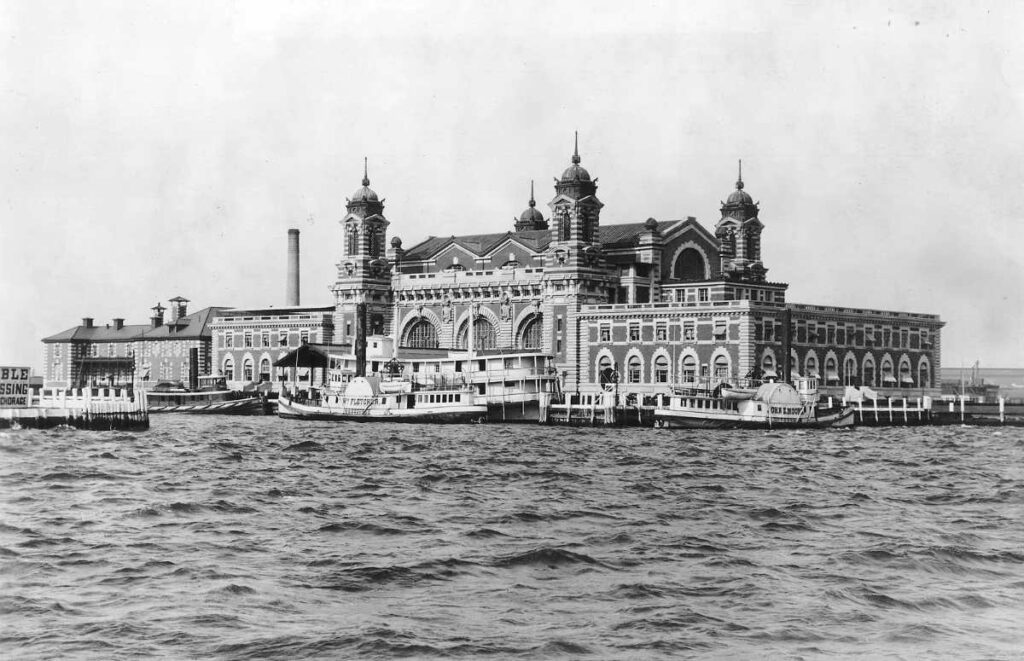
A wide variety of ethnic groups immigrated to the United States from Europe in the nineteenth century. In contrast, the majority of immigrants to Argentina came from Italy and Spain, while the majority of newcomers from Canada and Austria spoke English.
The flood of immigrants came in waves:
- Between 1820 and 1860, around five million people arrived in the United States of America, mostly from Northern and Western Europe. The famine in Ireland in 1845 brought a flood of immigrants from Ireland: between 1847 and 1854, more than a million Irish fled to the United States. Another 850,000 immigrants came from Germany.
- From 1860 to 1930, around 27 million immigrants came to the United States, mostly from Eastern and Southern Europe. Between 1900 and 1914, over 3 million immigrants came from Italy, a total of 2.5 million from Russia and the Baltic states, and over 3 million from elsewhere in Central and Eastern Europe. Fewer immigrants came from France and even fewer from Spain, as it had better ties with South America.
Meanwhile, in the second half of the nineteenth century, a small wave of immigration flowed from China to the west coast of America. Between 1854 and 1900, more than 300,000 Chinese immigrants entered the US in search of the gold found in California.
Why Did They Leave Their Homeland?

In the nineteenth century, the European continent was experiencing an uneasy period, boiling with social and political changes. During that century, however, Europe reached a level of civilization unprecedented in history, and changes within the continent were reflected overseas. New cities sprang up in the formerly rich north and then in the poorer, more rural south, bringing rural populations to city centers. Agriculture flourished. As wealth increased, so did the population’s ability to live in healthier conditions. Europe’s population more than doubled in a hundred years, from 190 to 423 million. Governments at the time allowed and even encouraged migration because it suited them.
Millions moved around the continent, and millions more—perhaps fifty million in all—went overseas to Brazil, New Zealand, Australia, Canada, South Africa, Argentina, and the USA. Some were fleeing their governments; others were just young and ambitious. Migration was often the result of personal decisions, motivated by fear, discontent, longing for a better life, and encouragement from those who had already left. One impulse that made emigration attractive was the increasing ease of travel conditions. The advent of steam and the steam-powered passenger ship in 1843 allowed for an unexpected increase in transoceanic travel.
America was the destination of most emigrants. The New World meant freedom from religious oppression, taxation, and social restrictions. But most importantly, the prospect of a better economic life. Already in the 1840s, an American citizen could earn five times more than his or her European counterpart. The land was cheap in the west, and since 1869, immigrants had been traveling west on the newly built transcontinental railroad. Even though the land was becoming scarcer, jobs were getting easier to find in the suddenly booming American cities. The advent of transportation allowed news to be sent quickly to Europe. One immigrant with a good job could inspire five, ten, or twenty others to migrate to the USA.
How Was America Affected by These Migrations?

One short-term consequence of the waves of immigration was that America became a “nation of nations.” In the early years of the century, almost one-seventh of Americans were born outside the United States. In some states, such as Wisconsin, nearly a quarter of the population was foreign-born.
The “melting pot” analogy often applied to the assimilation of newcomers to the United States only partially expresses reality. Immigrants who suddenly felt the danger of losing their identity tended to attach Americanness to the fabric they had created out of their culture and language. Immigration divided rather than united the country. In Britain, the Irish question was an Irish problem; for American politicians, the same phrase meant dealing with the problems of Irish immigrants.
Over time, every major city has had a Polish neighborhood or a “Little Italy.” The loom workers in Massachusetts spoke 45 different languages. In 1910, three-quarters of the population of New York, Chicago, Detroit, and Boston were immigrants and their American-born children. At that time, there were 540,000 Jews in a 1.5 square mile (4 square km) area on New York’s Lower East Side, and in 1912, one million Jews were living in New York, the equivalent of the State of Israel’s population when it was established in 1948.
Chicago’s history is full of being an immigrant city. In 1830, it was a frontier village. In 1870, it had 300,000 inhabitants. It was destroyed by fire in 1871, rebuilt, and 20 years later had a population of nearly 1 million people. Almost 80 percent of the population were immigrants or their children from 40 different nationalities. The character of many neighborhoods changed; the Irish and Germans made room for the newly arrived Italians and Jews, and violent fights and conflicts often broke out between them.
One short-term consequence of the waves of immigration was that America became a “nation of nations.” In the early years of the century, almost one-seventh of Americans were born outside the United States. In some states, such as Wisconsin, nearly a quarter of the population was foreign-born.
The “melting pot” analogy often applied to the assimilation of newcomers to the United States only partially expresses reality. Immigrants who suddenly felt the danger of losing their identity tended to attach Americanness to the fabric they had created out of their culture and language. Immigration divided rather than united the country. In Britain, the Irish question was an Irish problem; for American politicians, the same phrase meant dealing with the problems of Irish immigrants.
Over time, every major city has had a Polish neighborhood or a “Little Italy.” The loom workers in Massachusetts spoke 45 different languages. In 1910, three-quarters of the population of New York, Chicago, Detroit, and Boston were immigrants and their American-born children. At that time, there were 540,000 Jews in a 1.5 square mile (4 square km) area on New York’s Lower East Side, and in 1912, one million Jews were living in New York, the equivalent of the State of Israel’s population when it was established in 1948.
Chicago’s history is full of being an immigrant city. In 1830, it was a frontier village. In 1870, it had 300,000 inhabitants. It was destroyed by fire in 1871, rebuilt, and 20 years later had a population of nearly 1 million people. Almost 80 percent of the population were immigrants or their children from 40 different nationalities. The character of many neighborhoods changed; the Irish and Germans made room for the newly arrived Italians and Jews, and violent fights and conflicts often broke out between them.
Ellis Island Today
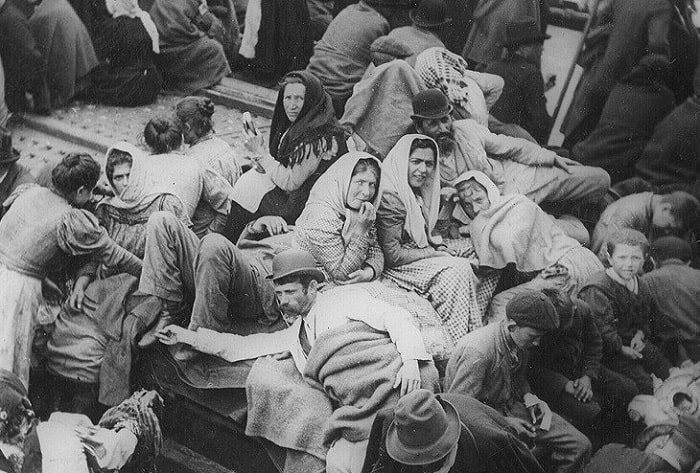
The outbreak of World War I reduced the flow of immigrants to the New World. Meanwhile, in the United States, the general trend appeared to be against immigrants. The reason was racism. In the developing and prospering American society, decision-makers were mostly well-educated whites of Northern European origin. As the influx of poor Southern European immigrants continued, the attitude of the American lobby in the government began to change. Politicians, who felt responsible for their American-born citizens, were faced with the problem of how to legally block the immigrants.
In general, Southern and Eastern Europeans were considered more ignorant than other Europeans. Despite a presidential veto, a literacy test was introduced in 1917 to slow down immigration. Other restrictions soon followed. A quota system was introduced in 1921 to limit immigrants of a particular nationality to 3 percent of the number of immigrants of the same nationality in the United States in 1910. This reduced the number of immigrants coming into the United States to 350,000 per year, which created discrimination in favor of established immigrant communities.
In 1943, the Ellis Island immigration station was moved to Manhattan, and the island was converted into a detention center for immigrants who were deported or had problems with their documents.
Bibliography:
- Bolino, August (1990). The Ellis Island source book. Washington, DC: Kensington Historical Press. ISBN 978-0-939133-03-1. OCLC 23941104.
- Cannato, V.J. (2009). American Passage: The History of Ellis Island. HarperCollins e-books. ISBN 978-0-06-194039-2.
- Coan, Peter M. (1997). Ellis Island Interviews: In Their Own Words. Barnes & Noble. ISBN 978-0-7607-5309-5.


